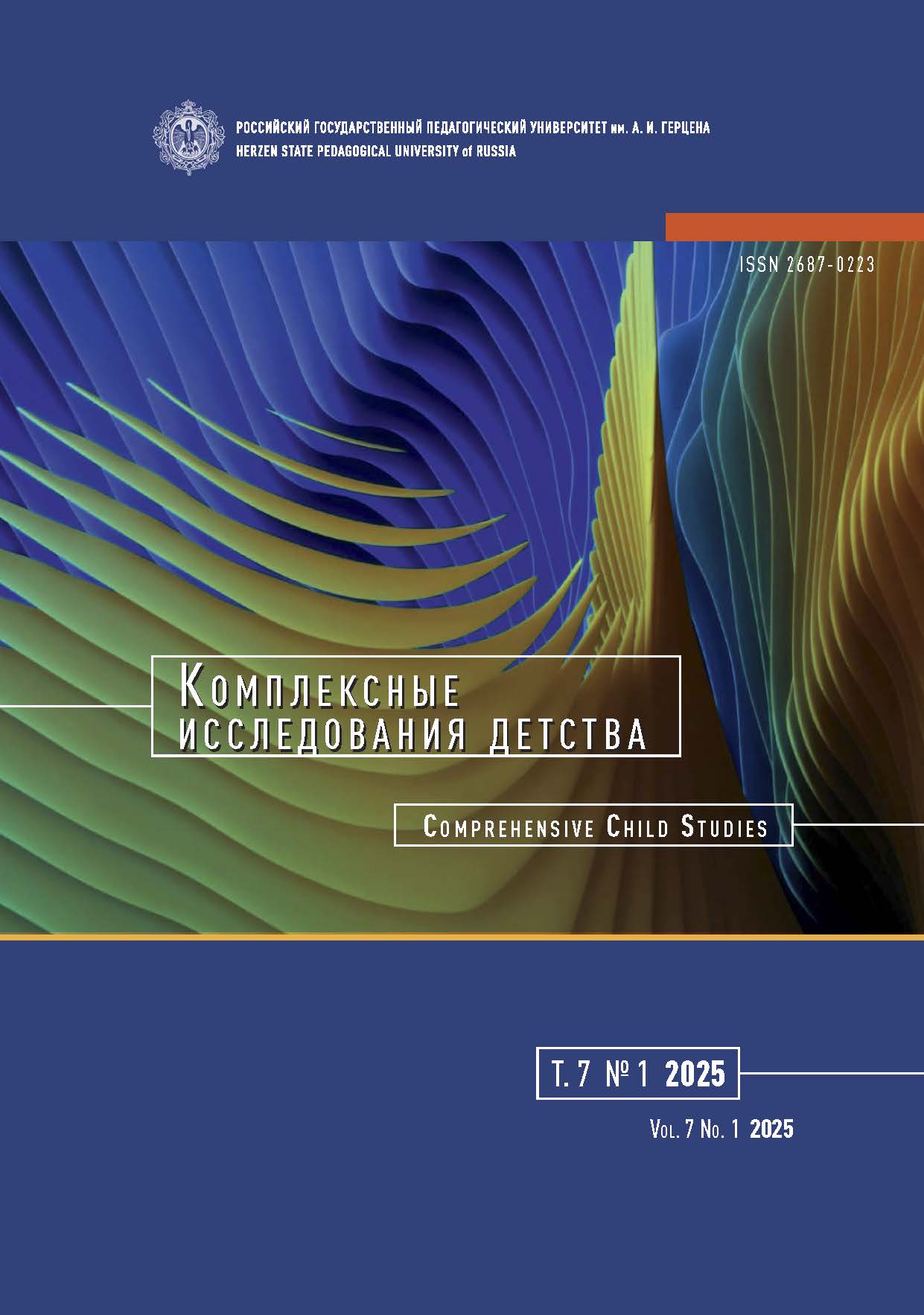Olfaction in autism: A literature review
DOI:
https://doi.org/10.33910/2687-0223-2025-7-1-58-66Keywords:
autism spectrum disorder, olfactory system, sensory integration, food neophobia, eating behavior, food selectivity, olfactory sensitivity, olfactory diagnostics, childrenAbstract
The article presents an overview of scientific research on olfactory features identified in children and adults with autism spectrum disorder (ASD). The data are analyzed in terms of their possible use in overcoming food neophobia, which is often observed in children with ASD.
The sense of smell plays an important role in the formation of taste sensations, making the study of olfactory features relevant. Research results obtained over the past 15 years have been quite contradictory. Several researchers have shown that individuals with ASD have significantly reduced olfactory sensitivity. Other studies have found that, despite a preserved ability to detect odors, individuals with ASD experience difficulties with odor identification and differentiation. The more pronounced the symptoms of ASD, the greater the difficulties participants had in recognizing smells. There is also a view that individuals with ASD are characterized by olfactory hyperreactivity.
Some critical remarks concern the research procedure. It is suggested that the test results of participants with ASD may be influenced by their cognitive abilities. Most methods for evaluating olfactory function rely on the participants’ verbal responses to perceived odorants. There are also promising electrophysiological methods that allow for more objective results. Further research is necessary, as the sense of smell can significantly affect one’s quality of life. It has been demonstrated that olfactory training reduces the manifestations of food neophobia in children with ASD.
Smell plays a major role in daily life, yet this role has long been underestimated by researchers. Increased or decreased sensitivity to odors in people with ASD is being actively studied, but research results are not yet widely applied in practice. Instrumental studies of olfaction show that it is possible to obtain data on the olfactory system even in non-verbal individuals with cognitive impairments. Further study of the sense of smell in relation to eating behavior opens new prospects for improving the quality of life of children and adults with ASD, as well as their families.
References
ЛИТЕРАТУРА
Бавыкина, И. А. (2019) Особенности физического развития и уровня нутриентов у детей с расстройствами аутистического спектра. Российский медико-биологический вестник имени академика И. П. Павлова, т. 27, № 2, с. 181–187. https://doi.org/10.23888/PAVLOVJ2019272181-187
Бавыкина, И. А., Звягин, А. А., Гусев, К. Ю., Панина, О. А. (2019) Нарушения пищевого поведения у детей с расстройствами аутистического спектра. Лечащий врач, № 3, с. 72.
Добрецов, К. Г., Каширский, Д. В. (2024) Изучение порога обоняния с помощью российской версии Сниффин Стикс теста. Российская ринология, т. 32, № 1, с. 6–10. https://doi.org/10.17116/rosrino2024320116
Дьяченко, А. В. (2020) Сенсорное развитие ребенка с РАС (обоняние). В кн.: Н. А. Палиева, Н. М. Борозинец, Ю. В. Прилепко (ред.). Ключевые компетенции педагога-дефектолога в контексте современной парадигмы образования лиц с ОВЗ: сборник научных трудов VIII Ежегодной научно-практической конференции Северо-Кавказского федерального университета «Университетская наука — региону». Ставрополь: Изд-во Северо-Кавказского федерального университета, с. 165–167.
Звягин, А. А., Бывакина, И. А., Бывакин, Д. В. (2018) Гастроэнтерологическая симптоматика у детей с расстройствами аутистического спектра. Вопросы детской диетологии, т. 16, № 2, с. 52–55. https://doi.org/10.20953/1727-5784-2018-2-52-55
Кнышева, Е. Р., Семенихина, Н. В. (2015) Использование мультисенсорной среды в психокоррекционной работе с детьми с РАС. В кн.: Н. Г. Назаров (ред.). XVI Съезд психиатров России. Всероссийская научно- практическая конференция с международным участием «Психиатрия на этапах реформ: проблемы и перспективы». Казань: Альта Астра, с. 203.
Мильнер, Е. Б., Щербак, Л. А. (2022) Особенности пищевого поведения у детей с РАС — вероятный фактор риска развития ожирения. Children’s Medicine of the North-West, т. 10, № 1, с. 75–81.
Михальчи, Е. В., Колесникова, И. В. (2019) Особенности развития тактильного и обонятельного утомления у лиц с расстройствами аутистического спектра. Вестник государственного гуманитарно-технологического университета, № 4, с. 14–23.
Нейсон, Б. (2016) О ключевых проблемах аутизма. Сенсорные аспекты аутизма. Аутизм и нарушения развития, т. 14, № 3 (52), с. 42–48. https://doi.org/10.17759/autdd.2016140304
Новикова, В. П., Волкова, И. С., Воронцова, Л. В. (2015) Влияние нутриентов на когнитивные функции. В кн.: Знание пропедевтики — основа клинического мышления педиатра. Сборник трудов, посвященный 80-летию профессора А. Я. Пучковой. СПб.: ИнформМед, с. 222–233.
Полякова, С. И., Коровина, Н. Ю., Чаплин, А. В. и др. (2018) Пищевая непереносимость и кишечная микробиота у детей с расстройствами аутистического спектра. Педиатрия. Журнал им. Г. Н. Сперанского, т. 97, № 2, с. 187–193. https://doi.org/10.24110/0031-403X-2018-97-2-187-193
Похабов, Д. Д., Туник, М. Е., Абрамов, В. Г. и др. (2019) Сравнительный анализ обоняния у здоровых людей, лиц с болезнью Паркинсона и с эссенциальным тремором. Доктор.Ру, № 6 (161), с. 12–17. https://doi.org/10.31550/17272378-2019-161-6-12-17
Ромусик, М. Н., Кулиш, Т. В. (2020) Особенности пищевого поведения детей с расстройством аутистического спектра. В кн.: Л. М. Кобрина (ред.). Специальное образование XXI века: от ранней помощи до профессиональной подготовки. СПб.: Изд-во ЛГУ им. А. С. Пушкина, с. 284–287.
Тогулева, В. К. (2016) Последствия неправильного пищевого поведения у детей с расстройствами аутистического спектра (РАС). Академия педагогических идей «Новация». Серия: Студенческий научный вестник, № 9, с. 14–25.
Чернова, Л. Н. (2021) Коморбидная патология у детей с расстройствами аутистического спектра. Врач, т. 32, № 8, с. 50–53. https://doi.org/10.29296/25877305-2021-08-09
Addo, R. N., Wiens, S., Nord, M., Larsson, M. (2017) Olfactory functions in adults with autism spectrum disorders. Perception, vol. 46, no. 3-4, pp. 530–537. https://doi.org/10.1177/0301006616686100
Ashwin, C., Chapman, E., Howells, J. et al. (2014) Enhanced olfactory sensitivity in autism spectrum conditions. Molecular Autism, no. 5, article 53. https://doi.org/10.1186/2040-2392-5-53
Cameron, E. L. (2018) Olfactory perception in children. World Journal of Otorhinolaryngology — Head Neck Surgery, vol. 4, no. 1, pp. 57–66. https://doi.org/10.1016/j.wjorl.2018.02.002
Dudova, I., Hrdlicka, M. (2013) Olfactory functions are not associated with autism severity in autism spectrum disorders. Neuropsychiatric Disease and Treatment, vol. 9, pp. 1847–1853. https://doi.org/10.2147/NDT.S54893
Galle, S. A., Courchesne, V., Mottron, L., Frasnelli, J. (2013) Olfaction in the autism spectrum. Perception, vol. 43, no. 3, pp. 341–355. https://doi.org/10.1068/p7337
Hugh, S. C., Siu, J., Hummel, T. et al. (2015) Olfactory testing in children using objective tools: Comparison of Sniffin’ Sticks and University of Pennsylvania Smell Identification Test (UPSIT). Journal of Otolaryngology — Head Neck Surgery, vol. 44, article 10. https://doi.org/10.1186/s40463-015-0061-y
Kinnaird, E., Stewart, C., Tchanturia, K. (2020) The relationship of autistic traits to taste and olfactory processing in anorexia nervosa. Molecular Autism, vol. 11, article 25. https://doi.org/10.1186/s13229-020-00331-8
Kumazaki, H., Muramatsu, T., Fujisawa, T. X. et al. (2016) Assessment of olfactory detection thresholds in children with autism spectrum disorders using a pulse ejection system. Molecular Autism, vol. 7, article 6. https://doi.org/10.1186/s13229-016-0071-2
Larsson, M., Tirado, C., Wiens, S. (2017) A meta-analysis of odor thresholds and odor identification in autism spectrum disorders. Frontiers in Psychology, vol. 8, article 679. https://doi.org/10.3389/fpsyg.2017.00679
Leon, M., Woo, C. C. (2022) Olfactory loss is a predisposing factor for depression, while olfactory enrichment is an effective treatment for depression. Frontiers in Neuroscience, vol. 16, article 1013363. https://doi.org/10.3389/fnins.2022.1013363
Lucas, J. C., Arambula, Z., Arambula, A. M. et al. (2022) Olfactory, auditory, and vestibular performance: Multisensory impairment is significantly associated with incident cognitive impairment. Frontiers in Neurology, vol. 13, article 910062. https://doi.org/10.3389/fneur.2022.910062
Luisier, A. C., Petitpierre, G., Clerc, B. A. et al. (2019) Effects of familiarization on odor hedonic responses and food choices in children with autism spectrum disorders. Autism, vol. 23, no. 6, pp. 1460–1471. https://doi.org/10.1177/1362361318815252
Stafford, L. D., Tsang, I., López, B. et al. (2017) Autistic traits associated with food neophobia but not olfactory sensitivity. Appetite, vol. 116, pp. 584–588. https://doi.org/10.1016/j.appet.2017.05.054
Sweigert, J. R., Tanja, St. J., Begay, K. K. et al. (2020) Characterizing olfactory function in children with autism spectrum disorder and children with sensory processing dysfunction. Brain Sciences, vol. 10, no. 6, article 362. https://doi.org/10.3390/brainsci10060362
Wicker, B., Monfardini, E., Royet, J. P. (2016) Olfactory processing in adults with autism spectrum disorders. Molecular Autism, vol. 7, article 4. https://doi.org/10.1186/s13229-016-0070-3
Yang, R., Zhang, G., Shen, Y. et al. (2022) Odor identification impairment in autism spectrum disorder might be associated with mitochondrial dysfunction. Asian Journal of Psychiatry, vol. 72, article 103072. https://doi.org/10.1016/j.ajp.2022.103072
REFERENCES
Addo, R. N., Wiens, S., Nord, M., Larsson, M. (2017) Olfactory functions in adults with autism spectrum disorders. Perception, vol. 46, no. 3-4, pp. 530–537. https://doi.org/10.1177/0301006616686100 (In English)
Ashwin, C., Chapman, E., Howells, J. et al. (2014) Enhanced olfactory sensitivity in autism spectrum conditions. Molecular Autism, no. 5, article 53. https://doi.org/10.1186/2040-2392-5-53 (In English)
Bavykina, I. A. (2019) Osobennosti fizicheskogo razvitiya i urovnya nutrientov u detej s rasstrojstvami autisticheskogo spektra [Peculiarities of physical development and of level of nutrients in children with autistic spectrum disorders]. Rossijskij mediko-biologicheskij vestnik imeni akademika I. P. Pavlova — I. P. Pavlov Russian Medical Biological Herald, vol. 27, no. 2, pp. 181–187. https://doi.org/10.23888/PAVLOVJ2019272181-187 (In Russian)
Bavykina, I. A., Zvyagin, A. A., Gusev, K. Yu., Panina, O. A. (2019) Narusheniya pishchevogo povedeniya u detej s rasstrojstvami autisticheskogo spektra. [Disorders of food behavior in children with autism spectrum disorders]. Lechashchij vrach, no. 3, pp. 72. (In Russian)
Cameron, E. L. (2018) Olfactory perception in children. World Journal of Otorhinolaryngology — Head Neck Surgery, vol. 4, no. 1, pp. 57–66. https://doi.org/10.1016/j.wjorl.2018.02.002 (In English)
Chernova, L. N. (2021) Komorbidnaya patologiya u detej s rasstrojstvami autisticheskogo spektra [Comorbid pathology in children with autism spectrum disorders]. Vrach, vol. 32, no. 8, pp. 50–53. https://doi.org/10.29296/25877305-2021-08-09 (In Russian)
D’yachenko, A. V. (2020) Sensornoe razvitie rebenka s RAS (obonyanie). [Sensory development of a child with ASD (sense of smell)]. In: N. A. Palieva, N. M. Borozinets, Yu. V. Prilepko (eds.). Klyuchevye kompetentsii pedagoga-defektologa v kontekste sovremennoj paradigmy obrazovaniya lits s OVZ: sbornik nauchnykh trudov VIII yezhegodnoj nauchno-prakticheskoj konferentsii Severo-Kavkazskogo federal’nogo universiteta “Universitetskaya nauka — regionu” [Key competencies of a teacher-defectologist in the context of the modern paradigm of education for persons with disabilities: a collection of scientific papers of the VIII annual scientific and practical conference of the North Caucasus Federal University “Un
Dobretsov, K. G., Kashirskij, D. V. (2024) Izucheniye poroga obonyaniya s pomoshch’yu rossijskoj versii Sniffin Stiks testa [Study of the threshold using Russian version of the Sniffin’s Stiks test]. Rossijskaya rinologiya — Russian Rhinology, vol. 32, no. 1, pp. 6–10. https://doi.org/10.17116/rosrino2024320116 (In Russian)
Dudova, I., Hrdlicka, M. (2013) Olfactory functions are not associated with autism severity in autism spectrum disorders. Neuropsychiatric Disease and Treatment, vol. 9, pp. 1847–1853. https://doi.org/10.2147/NDT.S54893 (In English)
Galle, S. A., Courchesne, V., Mottron, L., Frasnelli, J. (2013) Olfaction in the autism spectrum. Perception, vol. 43, no. 3, pp. 341–355. https://doi.org/10.1068/p7337 (In English)
Hugh, S. C., Siu, J., Hummel, T. et al. (2015) Olfactory testing in children using objective tools: Comparison of Sniffin’ Sticks and University of Pennsylvania Smell Identification Test (UPSIT). Journal of Otolaryngology — Head & Neck Surgery, vol. 44, article 10. https://doi.org/10.1186/s40463-015-0061-y (In English)
Kinnaird, E., Stewart, C., Tchanturia, K. (2020) The relationship of autistic traits to taste and olfactory processing in anorexia nervosa. Molecular Autism, vol. 11, article 25. https://doi.org/10.1186/s13229-020-00331-8 (In English)
Knysheva, E. R., Semenikhina, N. V. (2015) Ispol’zovaniye mul’tisensornoj sredy v psikhokorrektsionnoj rabote s det’mi s RAS. [Using a multisensory environment in psychocorrectional work with children with ASD]. In: N. G. Nazarov (ed.). XVI S’ezd psikhiatrov Rossii. Vserossiyskaya nauchno-prakticheskaya konferentsiya s mezhdunarodnym uchastiyem “Psikhiatriya na etapakh reform: problemy i perspektivy” [XVI congress of psychiatrists of Russia. All-Russian scientific and practical conference with international participation “Psychiatry at the stages of reforms: Problems and prospects”]. Kazan: Alta Astra Publ., p. 203. (In Russian)
Kumazaki, H., Muramatsu, T., Fujisawa, T. X. et al. (2016) Assessment of olfactory detection thresholds in children with autism spectrum disorders using a pulse ejection system. Molecular Autism, vol. 7, article 6. https://doi.org/10.1186/s13229-016-0071-2 (In English)
Larsson, M., Tirado, C., Wiens, S. (2017) A meta-analysis of odor thresholds and odor identification in autism spectrum disorders. Frontiers in Psychology, vol. 8, article 679. https://doi.org/10.3389/fpsyg.2017.00679 (In English)
Leon, M., Woo, C. C. (2022) Olfactory loss is a predisposing factor for depression, while olfactory enrichment is an effective treatment for depression. Frontiers in Neuroscience, vol. 16, article 1013363. https://doi.org/10.3389/fnins.2022.1013363 (In English)
Lucas, J. C., Arambula, Z., Arambula, A. M. et al. (2022) Olfactory, auditory, and vestibular performance: Multisensory impairment is significantly associated with incident cognitive impairment. Frontiers in Neurology, vol. 13, article 910062. https://doi.org/10.3389/fneur.2022.910062 (In English)
Luisier, A. C., Petitpierre, G., Clerc, B. A. et al. (2019) Effects of familiarization on odor hedonic responses and food choices in children with autism spectrum disorders. Autism, vol. 23, no. 6, pp. 1460–1471. https://doi.org/10.1177/1362361318815252 (In English)
Mikhal’chi, E. V., Kolesnikova, I. V. (2019) Osobennosti razvitiya taktil’nogo i obonyatel’nogo utomleniya u lits s rasstrojstvami autisticheskogo spektra [Peculiarities of the development of tactile and olfactoryfatigue in persons with disorders autism spectrum]. Vestnik gosudarstvennogo gumanitarno-tekhnologicheskogo universiteta — Vestnik of State University of Humanities and Technology, no. 4, pp. 14–23. (In Russian)
Milner, E. B., Shcherbak, L. A. (2022) Osobennosti pishchevogo povedeniya u detej s RAS — veroyatnyj faktor riska razvitiya ozhireniya. [Eating behavior in children with ASD are a risk factor for development of obesity]. Children’s Medicine of the North-West, vol. 10, no. 1, pp. 75–81. (In Russian)
Nejson, B. (2016) O klyuchevykh problemakh autizma. Sensornye aspekty autizma [Core challenges in autism. Sensory aspects of autism]. Autizm i narusheniya razvitiya — Autism and Developmental Disorders, vol. 14, no. 3 (52), pp. 42–48. https://doi.org/10.17759/autdd.2016140304 (In Russian)
Novikova, V. P., Volkova, I. S., Vorontsova, L. V. (2015) Vliyanie nutrientov na kognitivnye funktsii [Effects of nutrients on cognitive functions]. In: Znaniye propedevtiki — osnova klinicheskogo myshleniya pediatra. Sbornik trudov, posvyashchennyj 80-letiyu professors A. Ya. Puchkovoy [Knowledge of propedutics — the basis of clinical thinking a pediatrician. A collection of works dedicated to the 80th anniversary of professor A. Ya. Puchkova]. Saint Petersburg: InformMed Publ., pp. 222–233. (In Russian)
Pokhabov, D. D., Tunik, M. E., Abramov, V. G. et al. (2019) Sravnitel’nyj analiz obonyaniya u zdorovykh lyudej, lits s bolezn’yu Parkinsona i s essentsial’nym tremorom [A comparative analysis of olfactory function in healthy people and patients with Parkinson’s disease or essential tremor]. Doktor.Ru, no. 6 (161), pp. 12–17. https://doi.org/10.31550/17272378-2019-161-6-12-17 (In Russian)
Polyakova, S. I., Korovina, N. Yu., Chaplin, A. V. et al. (2018) Pishchevaya neperenosimost’ i kishechnaya mikrobiota u detej s rasstrojstvami autisticheskogo spektra [Food intolerance and intestinal microbiota in children with autism spectrum disorders]. Pediatriya. Zhurnal im. G. N. Speranskogo, vol. 97, no. 2, pp. 187–193. https://doi.org/10.24110/0031-403X-2018-97-2-187-193 (In Russian)
Romusik, M. N., Kulish, T. V. (2020) Osobennosti pishchevogo povedeniya detej s rasstrojstvom autisticheskogo spektra [Features of eating behavior in children with autistic spectrum disorder]. In: L. M. Kobrina (ed.). Spetsial’noe obrazovanie XXI veka: ot rannej pomoshchi do professional’noj podgotovki [Special education of the 21st century: From early assistance to professional training]. Saint Petersburg: Leningrad State University named after A. S. Pushkin Publ., pp. 284–287. (In Russian)
Stafford, L. D., Tsang, I., López, B. et al. (2017) Autistic traits associated with food neophobia but not olfactory sensitivity. Appetite, vol. 116, pp. 584–588. https://doi.org/10.1016/j.appet.2017.05.054 (In English)
Sweigert, J. R., Tanja, St. J., Begay, K. K. et al. (2020) Characterizing olfactory function in children with autism spectrum disorder and children with sensory processing dysfunction. Brain Sciences, vol. 10, no. 6, article 362. https://doi.org/10.3390/brainsci10060362 (In English)
Toguleva, V. K. (2016) Posledstviya nepravil’nogo pishchevogo povedeniya u detej s Rasstrojstvami autisticheskogo spektra (RAS). [Consequences of incorrect eating behaviors in children with autism spectrum disorders (ASD)]. Akademiya pedagogicheskikh idej Novatsiya. Seriya: Studencheskij nauchnyj vestnik — Academy of Pedagogical Ideas Novation. Series: Student Scientific Bulletin, no. 9, pp. 14–25. (In Russian)
Wicker, B., Monfardini, E., Royet, J. P. (2016) Olfactory processing in adults with autism spectrum disorders. Molecular Autism, vol. 7, article 4. https://doi.org/10.1186/s13229-016-0070-3 (In English)
Yang, R., Zhang, G., Shen, Y. et al. (2022) Odor identification impairment in autism spectrum disorder might be associated with mitochondrial dysfunction. Asian Journal of Psychiatry, vol. 72, article 103072. https://doi.org/10.1016/j.ajp.2022.103072 (In English)
Zvyagin, A. A., Byvakina, I. A., Byvakin, D. V. (2018) Gastroenterologicheskaya simptomatika u detej s rasstrojstvami autisticheskogo spektra [Gastroenterological symptoms in children with autism spectrum disorders]. Voprosy detskoj diyetologii — Pediatric Nutrition, vol. 16, no. 2, pp. 52–55. https://doi.org/10.20953/1727-5784-2018-2-52-55 (In Russian)
Downloads
Published
Issue
Section
License
Copyright (c) 2025 Victoria L. Efimova, Svetlana N. Nikoforova

This work is licensed under a Creative Commons Attribution-NonCommercial 4.0 International License.
The work is provided under the terms of the Public Offer and of Creative Commons public license Creative Commons Attribution 4.0 International (CC BY 4.0).
This license permits an unlimited number of users to copy and redistribute the material in any medium or format, and to remix, transform, and build upon the material for any purpose, including commercial use.
This license retains copyright for the authors but allows others to freely distribute, use, and adapt the work, on the mandatory condition that appropriate credit is given. Users must provide a correct link to the original publication in our journal, cite the authors' names, and indicate if any changes were made.
Copyright remains with the authors. The CC BY 4.0 license does not transfer rights to third parties but rather grants users prior permission for use, provided the attribution condition is met. Any use of the work will be governed by the terms of this license.







